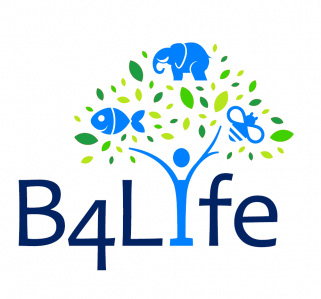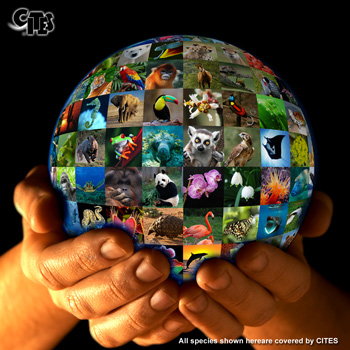CBD CoP12 side event
Does biodiversity matter for development? EU's Development Cooperation
launches its B4Life Flagship Initiative
Opening Statement
John E Scanlon, Secretary General, CITES
(Delivered by Milena Sosa Schmidt)
Pyeongchang, Republic of Korea, 16 October 2014
Mr. Janez Potocnik, EU Commissioner for the Environment, Session Chair, Mrs. Pia Bucella, Director of the Natural Capital Directorate, DG-ENV, European Commission, distinguished guests, friends and colleagues.
The European Union (EU), its Member States and its Commission have been longstanding and steadfast supporters of CITES – substantively, politically and financially.
The European Parliament, and its committees, have also expressed deep interest in CITES-related issues – as was most recently conveyed by the Parliament through its resolution on wildlife crime.
 The EU "Biodiversity for Life" flagship initiative is a most welcome boost to the longstanding commitment shown by the EU to biodiversity and to meeting the Aichi Biodiversity Targets and the objectives of the Strategic Plan on Biodiversity 2011-2020.
The EU "Biodiversity for Life" flagship initiative is a most welcome boost to the longstanding commitment shown by the EU to biodiversity and to meeting the Aichi Biodiversity Targets and the objectives of the Strategic Plan on Biodiversity 2011-2020. -----
Colleagues, the world has for decades confronted wildlife trafficking. Yet, in recent years, we have witnessed a serious spike in the scale of this illicit activity and a change in its nature.
It is clear that the dynamics of this highly destructive crime have changed – and so must our response – to ensure it matches the scale, nature, and immediacy of the risk that wildlife trafficking now poses to wild plants and animals, to people, to security and to economies.
-----
The poaching crisis that we are confronting is diminishing the value of national natural heritage in affected countries. Seven of the 14 World Heritage sites we monitor across Africa – through our EU-funded programme on Monitoring the Illegal Killing of Elephants, or MIKE – are today on the ‘in danger list’ as a result of poaching. The most recent addition is the Selous Reseve in the United Republic of Tanzania – and the rainforest of Atsinanana, Madagascar, has been and continues to be devastated by illegal rosewood harvesting and related illegal trade.
This destruction of natural heritage is depriving countries and local communities of future development options that could be gained from the sustainable use of their natural resources and it is robbing countries of potential tax revenues. CITES is working with the UNESCO World Heritage Centre to better protect these iconic sites.
Significant illegal killing, logging and collecting of wildlife is a source of insecurity in some regions and creates the perception of insecurity in others. This deters investment and poses a distinct threat to wildlife-based tourism, which brings considerable revenues to several Eastern and Southern African economies. For instance, according to World Bank data in 2012 Kenya earned some two billion dollars from international tourism, or 5% of its GDP.
Poaching for wild meat can also help spread zoonotic diseases such as the Ebola and Maburg viruses, challenging already over-stretched and under-resourced health services and posing a threat to global public health.
-----
Illegal killing, logging and collecting and related illegal trade are no longer local issues. Today they are occurring at an industrial scale and are coordinated by well-organized transnational criminal networks.
And such activities do not concern only iconic animal species, such as the elephant – but also plant species, especially many tree species. The illegal logging of trees and related trade is destroying natural forests and the services they provide.
Evidence from the MIKE programme and the ITTO-CITES programme on the sustainable management of CITES-listed tropical timber species shows that these criminal networks target areas where they encounter the least resistance, that is, where poverty is highest and governance and enforcement are weakest, and where they can easily induce the complicity of local hunters and corruptible officials.
Most of the illicit revenues from poaching accrue to the top end of these criminal networks, with only insignificant proportions going to the rural poor and underpaid officials who become complicit in the illegal trade, thereby undermining good governance and the rule of law.
It is essential to counter the threat of illegal killing and logging by improving law enforcement across the entire supply chain and reducing demand for illegal wildlife products in destination countries. These are well recognized as appropriate interventions – and CITES is working to provide coordinated support to countries and regions with its partners in the International Consortium on Combating Wildlife Crime (ICCWC) - INTERPOL, the United Nations Office on Drugs and Crime, the World Customs Organization and the World Bank.
Development assistance, however, also has a critical role to play in stemming the poaching crisis. Many of the areas that have important wildlife populations are amongst the poorest in Africa, most of which are not yet suitable or developed for tourism, or are lacking options for generating sustainable livelihoods. In these areas, wildlife seldom brings net benefits to local people; rather it often imposes net costs on them.
Wildlife can also come into conflict with people. A recent survey around Katavi National Park in Tanzania found that nearly half of the 500 hectares under cultivation around the park was destroyed by elephants in 2008, and 74% of respondents (who were mostly subsistence farmers) said that they did not get any benefits from the presence of elephants.

Wildlife conservation is related to issues of sound land use and resource property rights policies — both of which are lacking in parts of the developing world. A key challenge to the development community is to promote the social and economic development of poor communities, while retaining land use options that are not only compatible with conserving wildlife and its habitat, but which help ensure that net benefits from the sustainable use of wildlife and other natural resources accrue to those coexisting with wildlife.
-----
We are confronting a crisis and immediate actions must be taken in the front lines to enhance enforcement and minimize demand for illegal products. But there must also be benefits for local people.
Over the medium to longer term, people who coexist with wildlife and have a clear stake in its conservation will provide our best chance of achieving a sustainable future for wildlife and for people.
-----
This may all sound rather challenging. However, the positive news is that over the past few years there has been a global awakening at all political levels and across multiple agencies to the serious threats posed by illegal wildlife trafficking and to the need for immediate and longer term responses – and the EU has been a critical part of this collective effort.
At the 16th meeting of the Conference of the Parties to CITES held in Bangkok in March last year we witnessed unprecedented levels of international cooperation in combating illegal wildlife trafficking with a powerful suite of Resolutions and Decisions being adopted by consensus. The implementation and review of these is already well underway.
And at the London Conference on Illegal Wildlife Trade held in February this year, the London Declaration recognized the importance of engaging communities living with wildlife as active partners in conservation, by reducing human‐wildlife conflict and supporting community efforts to advance their rights and capacity to manage and benefit from wildlife and their habitats. The UN Development Programme has picked up on this issue and is currently investing resources to implement it at ground level.
-----
Against this backdrop, I think it is fair to say that we know what needs to be done and work is well underway – but we must continue to get on with it and take priority actions in quick time while we plan for longer term interventions.
Given the subject of today’s event, I would like to highlight four underlying factors that will underpin these collective efforts:
- Firstly, there must be support at the highest political level – political support that must translate into practical support in the front lines. Within the EU, Germany – with Gabon, France, and most recently the United Kingdom have each hosted major political events that have generated significant political momentum and support. Similar events have also been hosted outside of the EU, including by Botswana.
- Secondly, wildlife crime must be treated as a serious crime and in combating wildlife trafficking States must ensure a coordinated enforcement effort across the entire illegal supply chains – and deploy the same techniques as those used to combat other serious crimes.
- Thirdly, it is critical for the development and wildlife conservation communities to recognize that wildlife and habitat conservation is a development issue, inextricably linked to poverty eradication, economics, health, governance, security and social justice. It is imperative that wildlife conservation be mainstreamed into development interventions, seeking to maximize the benefits and minimize the losses to people and wildlife. Likewise, wildlife conservation interventions cannot ignore the development realities in and around the places we are trying to conserve.
- Finally, substantial additional financial support from multiple sources is required – while recognizing the EU for the strong financial support it already provides, including to ICCWC, the ITTO-CITES programme on tropical timber species, and to both MIKE and MIKES, which is evolving from monitoring the illegal killing of elephants to minimizing the illegal killing of endangered species. In this context, it is worth noting that the social, environmental, economic and security implications of illicit activities related to wildlife and their links to the Sustainable Development Goals should open up new funding sources.
While CITES continues to address the management and conservation of, and trade in, well-known species, it is also increasingly being used by States to ensure that trade in marine and timber species is legal, sustainable and traceable. For example, the number of tree species covered by the Convention has increased from 18 species listed in 1975 to more than 600 today largely as a result of over-harvesting and large volumes of illegal trade, which is placing high demands for technical and financial assistance on the ITTO-CITES programme.
-----
Colleagues, it will take a sustained, collective and multifaceted effort at all levels to win this fight and to move onto a pathway to a sustainable future where people and wildlife can coexist in harmony – but through maintaining and scaling up the sorts of collective efforts being discussed today we will get there.
Thank you.